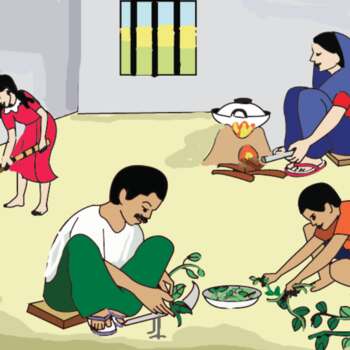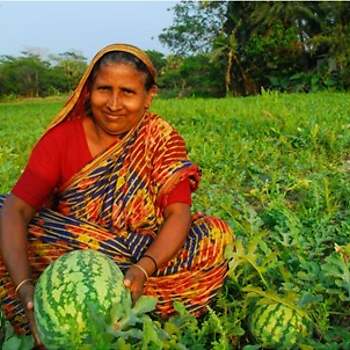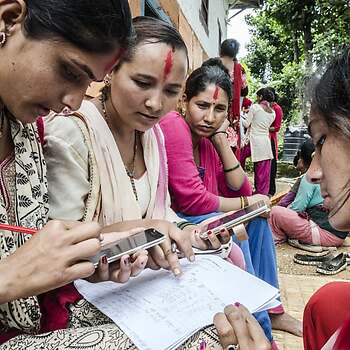Many changes have taken place in the roles of women and men farmers over the years in many countries. Both positive and more challenging. Producing crops for the market (cash crops), including selling vegetables and other produce at local markets or to traders, has given women a better opportunity to earn cash money. Women also earn money by rearing poultry or small ruminants or home processing of harvested crops and milk. This means that the disadvantaged position of women, including their limited access to resources, is gradually changing towards better realizing the potential of women to contribute to development. Thus women farmers have come a long way, whereby some first changes in attitudes and gender norms of men are also observed. These days men and women may more often work together on their farms, including more joint decision-making, both on agricultural production and the spending of income from increased productivity.
Women’s workload and unpaid care and domestic work
To avoid that women’s increased role in agricultural production leads to their overburdening, women’s unpaid domestic work is receiving more attention over time. Household and labour saving devices have been developed and introduced with varying results, e.g. improved cooking stoves, requiring less fuel wood (and reducing indoor air pollution), and improved drinking water supply, reducing the time to fetch water. But considering women’s still heavy responsibilities for care and domestic work, various organizations and projects actively pay attention to reduce overburdening, also by working towards recognition and redistribution of care and domestic work, thereby targeting also men, see also target 5.4 of SDG5. It is increasingly recognized that reducing women’s burden of care and domestic work is a precondition for their empowerment, thereby increasing their potential for productive and community work and thus to their contribute to overall socio-economic development. This is illustrated by the below example of how ActionAid reduced women’s unpaid care and domestic work, which was funded by the Dutch FLOW Fund.
ActionAid received funding from the Dutch FLOW Fund -both under FLOW-I (2012-2015) and FLOW-II (2016-2020)- to work with women farmers to improve their livelihoods and reduce the burden of unpaid care and domestic work. The latter is important to better enable women to increase productive work and take up leadership roles. The Women’s Food Security project in Ghana and Rwanda (FLOW-I) introduced climate resilient sustainable agricultural technologies and increased access to productive resources. At the same time this project reduced women’s unpaid work by labour-saving measures as improved access to drinking water and establishing day care centres, as well as by promoting a better sharing of domestic work with men. A successful tool to create awareness among men on women’s workload was the use of time diaries by men and women, and comparing those.
The POWER project (Promoting Opportunities for Women’s Empowerment and Rights) was the follow-up project under FLOW-II, and was implemented by ActionAid in Bangladesh, Ghana, Pakistan and Rwanda. The POWER project aimed to raise awareness and to mobilise and organise rural women to claim their rights as farmers and carers, linking agroecology, unpaid care work and violence against women.
Sources: Funding Leadership and Opportunities for Women: FLOW 2012 – 2015 (Final Report – Organisations), MoFA, PwC and Femconsult, 2017; and https://powerproject.actionaid.org/learning/
Use of mobile phones and ICT
The availability of mobile phones, increasingly also accessible to women farmers in many countries, turned out a great help to expand their access to sources of information and market actors. This works even better where agricultural extension targets also women farmers on topics as market orientation and access to information .
For example, all Farmer Field Schools of the Dutch funded Blue Gold Program in Bangladesh, including those on homestead production, addressed market linkages and access to extension. This included the introduction of reliable traders to the (men and women) FFS participants, and sharing phone numbers of such traders, sources for market information, and service providers, including extension agents. This enabled a much greater involvement of women farmers in input supply and selling of agricultural produce, see the example of Layli, a farmer who participated in the Blue Gold Program (BGP).
Layli, a woman farmer of 45 years of age, has a handicapped husband. She was already used to do most work on the land, up till 7 hours a day. She was involved in some marketing, but her husband took all decisions. At the time of the interview (early April 2018) Layli is cultivating watermelon and the harvest is due within two weeks. She expects that her watermelons will fetch her 6 lacs of taka (1 lac = 0.1 million), while she spent about 1.2 lacs on inputs, including ploughing. The expected profit is nearly 5 lacs, which is more than 4 times the total profit of 1.1 lac of the two rice harvests, Aus and Aman. Layli knows that watermelon is a risky business. Last year the rain affected her watermelon production, leaving her with a ‘meagre’ cash profit of 1 lac for all crops of 2017.
She said that due to the training on market linkages and women’s empowerment (by the Blue Gold Program) she is now more confident and takes more responsibilities. Last year she cultivated watermelon on 160 decimal of land, 80 of their own and 80 leased, but this year she felt she could manage more and cultivated watermelon on 240 decimals, leasing 160 decimals. Before the training she used to just sell the watermelons to a trader accepting the offered price, but now she is bargaining after checking the watermelon price in Khulna, Jessore and Dhaka by using her mobile phone to collect this information. The wholesaler is now offering her a higher price than before. All this led to a higher income for her and her family. She also inspired her women neighbours, who are now seeking advice from her.
Layli about the changes due to BGP: “I feel more empowered now, as more men in the community acknowledge and respect women as farmers after BGP started. That provides me the space to be more outspoken and more aware about my rights as a farmer”.
The use of ICT technologies, other than using mobile phones for contacting service providers and market actors, has great potential to narrow the gap between small farmers and agricultural extension and agricultural research. In the last 1-2 decades there have been many innovative ICT initiatives for agricultural extension around the world, also aiming to reach small farmers. These initiatives ranged from village knowledge centres to innovative radio and television, and includes the use of smart phones. An example of audio-focused ICT innovation is the Talking Book, a ‘low cost audio computer’, being used by Literacy Bridge in agricultural projects to address both literacy and gender gaps, especially for women and illiterate farmers.
Still there is the challenge that developers of such ICT solutions overlook the special needs of women (and illiterate male) farmers, who are often in a disadvantaged position to use ICT solutions. The below example presents the findings of an experiment to empower women famers by purposely targeting also women farmers with ICT-based agricultural extension information.
A field experience in Uganda (IFPRI/CGIAR) provided both men and women farmers with direct access to video-based extension information on maize production, also featuring women as information providers in the videos themselves. This led to the following insights for ICT-enabled extension programs:
- When women directly receive information (i.e. not through their husbands) this has a positive effect on women’s knowledge.
- Women participated more in decision-making when they had received information, reducing men’s individual decision-making.
- Women who received information increased the actual adoption of recommended inputs and management practices.
- The total area of the household maize plots managed by women increased when only women (and not men) were provided with information.
- When women received information, they were also more likely to independently sell maize.
Source: https://pim.cgiar.org/2020/03/09/womens-empowerment-agricultural-extension-and-digitalization/


